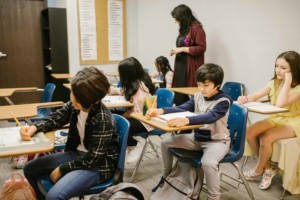Is the End of Standards-Based Teaching Near?

The 1983 publication of A Nation at Risk sounded the alarm about America’s failing public schools and ushered in the standards-based reform movement.
A little more than 37 years later the nation is at risk again. What we face now is not the fear of inadequate schools but the fear of contagion. This round of fear will produce more dramatic changes in student outcomes, education policy, assessment, and pedagogy than its predecessor.
As many readers know, I returned to the classroom last year after 15 years in upper management at the Buck Institute for Education (PBLWorks) and the Partnership for 21st Century Learning. This summer I have been preparing to teach in the fall, which in my case always entails a review of the standards I’m expected to cover.
As a sixth-grade teacher in California, I’m responsible for my students developing mastery of 52 Common Core-infused English/Language Arts standards, 30 linked social studies literacy standards, and 48 social studies standards.
In a normal year, each of my students would receive 300 daily minutes of total instruction, 120 of which would be focused on my subject areas. But that was then and this is now. Earlier this summer the California legislature passed SB 98. One of the key policies in that bill is a reduction of instructional minutes from 300 daily to 240 daily (online or face-to-face) for students in grades 4-8.
Those screams you hear are from teachers who are terrified at the thought of covering more than 100 standards in 20 percent less time.
This begs the question: Will COVID-19 strike a mortal blow to the coverage mentality that has dominated U.S. education for 37 years?
As one of the doyens of project-based learning, I take a dismal view of coverage. I would rather my students develop and retain a deep mastery of essential ideas and skills than an ephemeral familiarity with thousands of facts.
I turned to colleagues to see if my thinking was in alignment with theirs. Teresa Dempsey, the director of professional learning and leadership for the Fairfield County (OH) Educational Service Center, had this to say: “Though these proposed time constraints seem daunting and formidable, it is possible. It means that teachers are going to have to be strategic in their choice of research-based instructional methodology that is proven to effectively teach deep content (power standards) in efficient ways.”
Paul Curtis, the Director of Curriculum at the New Tech Network, focused on the need to make dramatic shifts in practice rather than half-hearted attempts to force the square pegs of traditional methodologies into the round holes of distance learning: “Too many educators are facing school closures by attempting to replicate traditional learning structures in a virtual way. They are trapped in a teacher-centric mindset that focuses on learning activities (worksheets, homework, packets, lectures, etc.) that barely worked in classrooms of captured learners. The opportunity to create a more student-centered, differentiated, and personalized learning approach is in front of us.”
I wanted as well to tap the thinking of colleagues in the corporate world. Stephan Turnipseed, the Executive Vice President and Chief Strategy Officer for Pitsco, directed his attention to the big brother of coverage, i.e., seat time: “I believe the biggest opportunity we have as we emerge from the COVID-19 inspired shifts in education is to finally place the Carnegie Unit in a mausoleum. It may have worked in an assembly line economy. It has no place in the networked economy of today. The COVID-19 crisis has laid bare the fundamental truth that for many years schools have largely been used for daycare, general wellbeing and upkeep of children, and lastly education. Of the three education has been by far the least effective, in no small part, due to the focus on instructional minutes rather than actual deeper learning by children. COVID-19 provides the fertile ground of change to foster a deeper learning revolution, unshackled from the drip, drip, drip of minutes.”
Steve Zipkes, the founding principal of Cedars International Next Generation High School in Austin, Texas, focused as well on the opportunity this crisis presents educators: “As an education system this is going to have to be a nationwide effort. For years the curriculum people have been piling standards higher and deeper until it has become impossible to cover everything. Curriculum experts at the state and national levels need to start thinking about what are the key concepts and skills that students need to be successful at the next grade level or to graduate. Then we need to revise our curriculum to focus on that.”
I agree with Zipkes, but I and millions of other teachers confront the fierce urgency of now. School will have opened in dozens of states by the time you read this. What we can do at this moment is to make key commitments to ourselves and our students.
While doing research for this piece I ran across a 2015 Edutopia article entitled “Why Content Coverage is Over: A Manifesto!” The author, my longtime colleague Andrew Miller, was prescient in asking teachers to proudly proclaim the following:
- I am committed to deeper and life-long learning for my students.
- I will no longer submit to the pressure to cover content.
- I will use curriculum and pacing guides for what they are intended: guides, not set-in-stone learning.
- I will continue to make the best decisions for my students, rather than let the pressure to cover content drive my teaching.
I firmly believe that Miller and my other colleagues are correct. Let’s see if anyone takes advantage of the crisis to make meaningful change.
For more, see:
- Teaching the Common Core Standards Means Designing Real and Engaging Learning Experiences
- Six Projects to Meet Common Core and ISTE Standards
- What Does it REALLY Mean to Do Standards-Based Grading?
Stay in-the-know with innovations in learning by signing up for the weekly Smart Update.







Darren Draper
What’s wrong with both a commitment to standards AND Miller’s principles? Why must they be mutually exclusive?